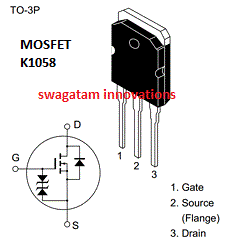PelliX
Well-Known Member
- Joined
- Jun 16, 2020
- Messages
- 7,225
- Reaction score
- 14,685
So, after one or two hiccups this morning...
The 2SJ49 is a P-channel MOSFET: https://www.alldatasheet.com/datasheet-pdf/view/63100/HITACHI/2SJ49.html
The 2SK134 is an N-channel MOSFET: https://www.alldatasheet.com/datasheet-pdf/view/63172/HITACHI/2SK134.html
Simply put, they're the same thing, just inverted. The test methods also differ only in that respect. They both share the same pinout: 1 = Gate, 2 = Drain, 3 = Source.
You can think of them as a switch. If voltage is applied to the Gate, the Drain and Source are internally connected. The direction in which the current can flow is opposite between the two types (Negative vs Positive channel, let's say). This comes with a caveat, though; If you measure the Gate with your multimeter, you're applying voltage to the FET and it will even hold that charge for a bit - obviously there's no danger here, but it can screw with your readings. Short the FET first and then check Drain to Source and Source to Drain resistance. Should be extremely practically infinite. If you now check the resistance from the Gate to the Drain and Source - you've charged the FET. NOW, you should get continuity from Drain to Source or Source to Drain (depending on the FET type). Short it again and that 'path' should be an open circuit again.
While there are a lot more expensive options out there, a simple component tester will generally tell you if your FET or transistor is shot.
You can find these on eBay, etc - generally don't cost more than a tenner or two and are well worth it if in doubt. No need to work out the pinouts, either - plug and play. It will tell you the pinout, as it happens. Sometimes, you can run into a component that only breaks down and malfunctions at higher loads and voltages than the tester provides, but this is fairly uncommon, really. Also gives you a low voltage capacitor test which is handy.
The 2SJ49 is a P-channel MOSFET: https://www.alldatasheet.com/datasheet-pdf/view/63100/HITACHI/2SJ49.html
The 2SK134 is an N-channel MOSFET: https://www.alldatasheet.com/datasheet-pdf/view/63172/HITACHI/2SK134.html
Simply put, they're the same thing, just inverted. The test methods also differ only in that respect. They both share the same pinout: 1 = Gate, 2 = Drain, 3 = Source.
You can think of them as a switch. If voltage is applied to the Gate, the Drain and Source are internally connected. The direction in which the current can flow is opposite between the two types (Negative vs Positive channel, let's say). This comes with a caveat, though; If you measure the Gate with your multimeter, you're applying voltage to the FET and it will even hold that charge for a bit - obviously there's no danger here, but it can screw with your readings. Short the FET first and then check Drain to Source and Source to Drain resistance. Should be extremely practically infinite. If you now check the resistance from the Gate to the Drain and Source - you've charged the FET. NOW, you should get continuity from Drain to Source or Source to Drain (depending on the FET type). Short it again and that 'path' should be an open circuit again.
While there are a lot more expensive options out there, a simple component tester will generally tell you if your FET or transistor is shot.
You can find these on eBay, etc - generally don't cost more than a tenner or two and are well worth it if in doubt. No need to work out the pinouts, either - plug and play. It will tell you the pinout, as it happens. Sometimes, you can run into a component that only breaks down and malfunctions at higher loads and voltages than the tester provides, but this is fairly uncommon, really. Also gives you a low voltage capacitor test which is handy.








 )!
)!